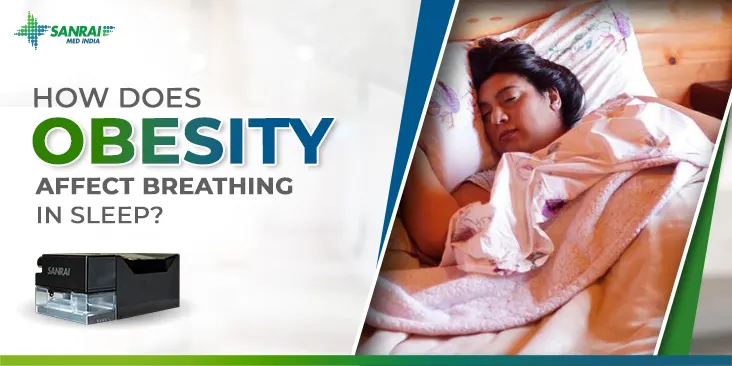How Does Obesity Affect Breathing in Sleep?
Sleep-Related Hypoventilation Syndrome (SRHS)
SRHS, also called Obesity Hypoventilation Syndrome, occurs when breathing becomes too shallow or slow during sleep, resulting in low oxygen and high carbon dioxide levels. Excess fat around the chest, neck, and abdomen restricts lung expansion and narrows the upper airway, especially when muscles relax during sleep.
If left untreated, SRHS can lead to:
Pulmonary hypertension
Right-sided heart failure
Cognitive impairment and persistent fatigue
Early recognition is crucial because symptoms are often subtle and may be mistaken for general tiredness.
How Obesity Affects Breathing Mechanics
Obesity impacts breathing through several mechanisms:
Chest and Abdominal Pressure: Excess fat pushes against the diaphragm, reducing lung expansion.
Narrowed Airways: Fat deposits around the neck compress the upper airway.
Increased Respiratory Workload: Breathing requires more effort to maintain oxygen levels.
Impaired Gas Exchange: Restricted airflow leads to low oxygen (hypoxemia) and high carbon dioxide (hypercapnia).
These factors together contribute to sleep disruption, daytime fatigue, and increased cardiovascular stress.
Obesity and Sleep-Related Breathing Disorders
Obstructive Sleep Apnea (OSA)
OSA is characterized by repeated partial or complete airway obstruction during sleep, causing breathing pauses that last 10 seconds or more.
Common symptoms include:
Loud snoring
Gasping or choking during sleep
Morning headaches
Daytime sleepiness and difficulty concentrating
Obesity is a major risk factor, with 70–90% of OSA patients being overweight or obese.
Sleep-Related Hypoventilation Syndrome (SRHS)
SRHS occurs when shallow breathing prevents adequate oxygen intake and carbon dioxide elimination. Unlike OSA, SRHS primarily results from respiratory inefficiency due to obesity, and can lead to pulmonary hypertension, heart strain, and chronic fatigue.
Recognizing Signs and Symptoms
Symptoms of obesity-related sleep disorders include:
Loud snoring and choking during sleep
Morning headaches or dry mouth
Feeling unrefreshed after sleep
Excessive daytime fatigue
Difficulty concentrating or memory problems
Early detection is essential for preventing long-term health complications.
Long-Term Health Risks
Untreated obesity-related sleep disorders can result in:
Cardiovascular complications: Hypertension, arrhythmias, heart attack, stroke
Pulmonary hypertension: Chronic hypoxia increases lung artery pressure
Metabolic issues: Worsened insulin resistance and diabetes
Cognitive impairment: Fatigue, reduced focus, and memory problems
Reduced life expectancy: Persistent oxygen deprivation can shorten lifespan
High Flow Rates in CPAP Therapy
CPAP therapy manages OSA and SRHS, with flow rates based on obesity, airway resistance and severity. Mild OSA needs 20-30 L/min, moderate 30-35 L/min, severe 45-60 L/min, and SRHS 40-70 L/min, adjusted for comfort, ventilation, and oxygenation.
Benefits of High Flow CPAP Therapy
Overcoming airway collapse: Keeps the airway open even when muscles relax.
Reducing resistance: Easier airflow decreases effort required for breathing.
Improved oxygenation: Maintains stable oxygen levels, reducing desaturation.
Alleviating symptoms: Reduces snoring, daytime fatigue, and cognitive impairment.
Individualized settings: Flow rates are personalized based on severity and response.
High flow CPAP therapy is particularly effective for obese patients, whose airway resistance and lung load are higher.
Reve Auto CPAP Device – Advanced Sleep Therapy
For patients with Obstructive Sleep Apnea, the Reve Auto CPAP Device offers intelligent, adaptive therapy that ensures restful sleep and optimal airway management.
Key Features:
High Flow Rate (190 L/min): Maintains open airways for patients of all body sizes.
Whisper-Quiet Operation (24.6 dB): Allows uninterrupted sleep for both the patient and their partner.
No Foam Circuit: Calibrates circuit resistance for cleaner, safer, and more effective therapy.
Auto CPAP Mode: Detects and responds to obstructive and central apneas in real time.
Comfort Control Plus & Smart Ramp: Smoothly adjusts pressure during sleep for a natural inhale and exhale.
Heated Humidifier & Tubing: Prevents dryness and irritation.
Compact & Travel-Friendly: Easy to carry for home or travel use.
Optional Cloud Connectivity: Enables remote therapy tracking and data sharing with healthcare providers.
The Reve Auto CPAP Device is designed for both beginners and experienced users, providing smart, personalized therapy for effective oxygenation and airway support.
Diagnosis and Treatment
Diagnosis
Sleep disorders are diagnosed through:
Polysomnography (sleep study): Monitors breathing, oxygen, heart rate, and sleep stages
Home sleep tests: Preliminary assessment for mild cases
Arterial blood gas analysis: Measures oxygen and carbon dioxide levels
Pulmonary function tests: Evaluates lung capacity
Treatment Approaches
Weight Management: Even modest weight loss can improve airway function
CPAP Therapy: Maintains airway patency and improves oxygenation
Lifestyle Adjustments: Regular exercise, balanced diet, avoiding alcohol and sedatives
Positional Therapy: Side sleeping reduces obstruction
Surgical Options: For severe cases, airway or bariatric surgery
Obesity impacts sleep breathing, raising OSA and SRHS risks. High-flow CPAP therapy maintains airways and oxygenation effectively. The Reve Auto CPAP offers 190 L/min, quiet, adaptive therapy. Combines with weight management and lifestyle changes, it ensures better sleep and overall health.






